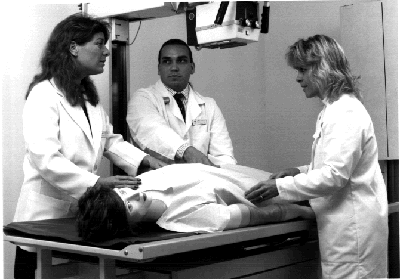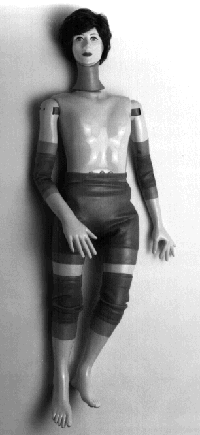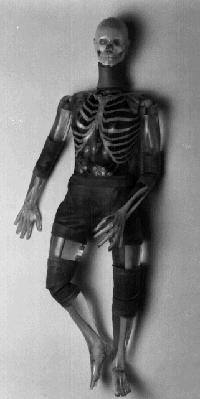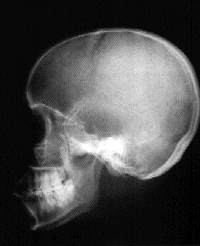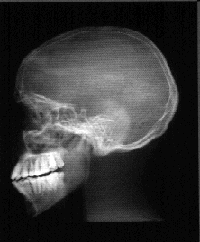|
RSD PIXY® Phantoms |
|
|
|
The Anthropomorphic Teaching/Training Phantom
PIXY® is a small, female, anthropomorphic phantom designed
specifically for training radiologic technologists. PIXY is 5 ft. 1 in. tall
and weighs 105 lbs. She is a repeatable, virtually indestructible and
convenient substitute for patients. She is
made of tissue-equivalent materials and has life-like articulations. Students
have no difficulty in maneuvering PIXY into most desired positions. PIXY is
used to demonstrate anatomy and evaluate positioning and imaging technique,
including kVp, mAs, contrast, optical density, OFD and TFD. Radiographs of
PIXY are optically equivalent in density and contrast to human patients. PIXY
permits unlimited exposures and tolerates trainee errors. PIXY ANATOMY
PIXY
shoulders have ball and socket joints; elbows and knees flex 90º to 100º. Hips
flex 130º with 30º hyperextension. A "frog position" is made
possible by lateral flexion at the hips. The right hand is molded with
fingers positioned for an AP view, while the left hand is in an
oblique-lateral position. The left foot is in full plantarflexion; the right
foot is in a neutral position. Cl, C2,
C6 and C7 were converted to mechanical nylon joints because educators in the
field prefer full positioning capabilities for the head. The design permits
the remaining neck vertebrae to be fixed in a normal position, while assuring
a full range of head motion. PIXY
contains abdominal and pelvic organs: stomach, gall bladder, urinary bladder,
kidneys, rectum and sigmoid flexure. These accept air, water or contrast
media and can be easily flushed after use. Custom fractures, custom
pathologies and arterial trees are optional. PIXY MATERIALS Soft Tissues PIXY is
available in opaque or transparent tissue-equivalent materials. The
transparent PIXY has visible organs and skeleton except at the hips, knees,
and elbows, which are opaque because, as on the opaque PIXY, latex coverings
are needed to retain tissue-equivalent gels for soft-tissue continuity at
these articulations. Two-ply coverings protect against gel leakage. Lungs
Standard
PIXY lungs are tissue-equivalent foam with a mass density of inflated human
lungs (0.30 g/cc). They are connected to the oro-nasal cavity by the stem
bronchi and trachea. The oro-nasal pharynx is filled with a nearly
air-equivalent foam. Optional animal lungs, which duplicate the intricate
detail of the vascular trees, are available. These lungs are fixed in the
inflated state and are molded to conform to the pleural cavities of the
phantom. The pulmonary arteries are injected with a blood-equivalent plastic.
In addition, low or high contrast material may be selected by the user. |
|
|
|
|
|
OPAQUE
PIXY |
|
TRANSPARENT
PIXY |
|
Skeletons RSD*
polymer skeletons, with trabecular patterns, fit precisely within the
soft-tissue molds. The bones of a single individual, who matched PIXY molds
very closely, were used in making the RSD skeletal molds. Skeletons have a
fixed chemical composition (no
osteoporosis or contamination). The medullary cavities were reproduced, with
only minor simplification, to make molds for the spongiosa, about which the
cortical bone is molded. Both cortical bone and spongiosa are
radio-equivalent to natural bone. Skeletons
are in continuous production, so quick shipments are routine. Human skeletons
are available, nevertheless, for users who desire them. There is a surcharge
to cover the high cost of rarely-available natural skeletons and for added
labor for their rework.
The
matching of skeletons and soft-tissues permits external and bony landmarks to
coincide. The position of bones within the soft tissues is anatomically
correct. The
detail cast into RSD skeletons is considered a triumph of the sculptural
moldmaker's craft. The skull, for example, has frontal and sphenoidal
sinuses, ethmoidal and mastoid air cells and the auditory ossicles. Bone
sutures are radiographically visible. REFURBISHMENT RSD
offers PIXY refurbishment service which corrects the wear and
tear resulting from usage over an extended period of time and restores PIXY
to its original condition. This service includes repair of minor bone
fractures of hands and feet. Quotes are furnished upon request for more
extensive damage. * Highly detailed polymer skeletons which reproduce the shape, mass
density and attenuation coefficients of the cortical bone and spongiosa,
allow continuous production of phantoms instead of sporadic production due to
limited availability, variable size and uncertain chemical composition of
human skeletons. |
|
|
|
|
|
NATURAL SKULL: Note the compromises
needed to fit a variable skull into a fixed head mold (on right) |
|
RSD SKULL: The intricate shape of the skull requires
that it be made in four parts, plus the mandible. Manufacturing artifacts
have been minimized |
|
ORDERING INFORMATION |
|
|
MODEL |
DESCRIPTION |
|
RS-102 |
PIXY with permanent storage case; contains stomach, gall bladder,
urinary bladder, right and left kidneys, rectum and sigmoid flexure. |
|
RS-102T |
Same as RS-102 PIXY but in transparent material |
|
RS-150 |
Arterial Tree |
|
RS-157 |
Actual Lungs (animal) to replace standard plastic foam lungs |
|
RS-102SP |
Custom Fracture and Pathologies |
|
RS-102R |
Standard PIXY Refurbishment (major repairs quoted upon request) |
|
|
NOTE: Arterial tree, actual lungs, custom fractures
and pathologies must be ordered together with phantom. They can't be
retrofitted. |
© Elimpex-Medizintechnik, Spechtgasse 32, A-2340
Moedling, Austria
phone +43-2236-410450
fax +43-2236-410459
